#jeju dol hareubang
Text
My attempt to analyze Wishing Cairn EGO
Wish me luck
So Abnormality from which we get these EGOs called Pagoda Veneration or Tapdori, which is Korean tradition of walking and dancing around Pagoda, which is used to mark burial place of Buddha in circles. It was for veneration of Buddha in the beginning, but with time became a fun tradition for festivals(as I understood usually performed on April 1st)
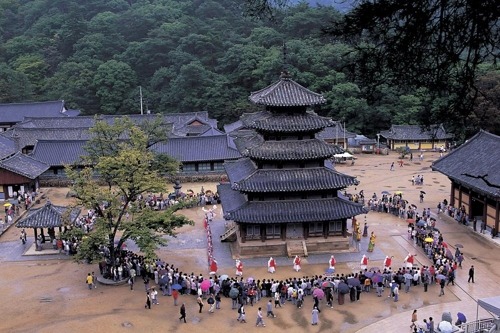
However, instead of traditional pagoda, we see stone towers, which are like a more symbolic version of it, that people built by themselves wishing for good luck.
The figure that stacks these towers reminds us(and then is blatantly called in Yi Sang's EGO passive) Dol Hareubang, Stone grandpa, which is a type of rock statue found on Jeju Island. The exact reason for creating these statues is now kinda forgotten, but it's believed that they are gods offering protection from Demons. However, I could not find any connections between them and pagodas or wish towers, so if you know more, please inform me.

So, in Mirror Dungeon event, we see how this creature stacks stones, and we need to decide how to perceive them - as wish towers or cairn tomb.
But seems it's both
If we decide that it's wish tower, we can try to place a stone over making our wish(Sloth/Gloom check) and get Stone Tomb. Kinda interesting how we decided to consider it's an innocent wish tower, but in the end, it is still called "Tomb."
If we decide that it's a burial, we can try to bring down the cairn(Wrath/Envy check) and surprisingly don't find anything disturbing, only some money.
And I guess second choice is easier to analyze, in rightful Wrath we trying to save someone from being buried alive, sin makes sense.
But why is making a wish requires Sloth and Gloom? Well, my guess is that it symbolises passivity. Like, instead of doing something we just make wishes?
However, it's interesting that Yi Sang in his EGO that requires 4 Sloth and 1 Gloom to charge up, doesn't even make a wish. He seems more as a keeper of them, and in corroded condition asks to give him your wish " Speak unto me your wish...Vocalize your eagerness"

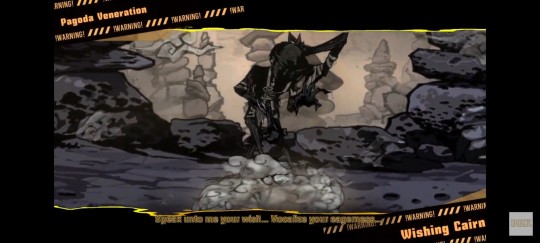
Don's EGO requires only 2 Sloth and 1 Wrath and 1 Pride, and in contrast with Yi Sang she's very vocal and active with her wish, announcing it and immediately following with action.
Wrath could be needed for sheer violence of her desires.

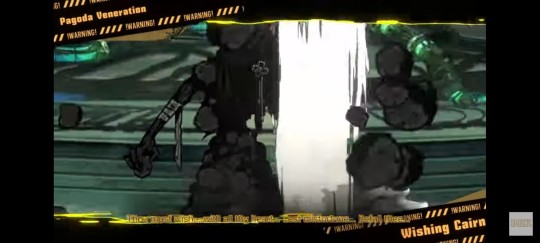
So Don is the one who makes wish, while Yi Sang is a person listening to it.
It's also interesting that his passive named after god-guardian, while Don's is "Fallen stone pagoda" which happens if we make a wish caressly or destroy on purpose. In her situation, I think it is the first option.
It also could explain why using EGO they gain weakness to gluttony. If they wish caressly and greedily, the tower will fall without fulfilling anything.
Gloom weakness could be about the danger of losing belief in power of wish fulfillment? Like if they start to doubt power of cairns, they won't work?
Like this fragilities forces them to balance between not losing trust in wishes and not overdepending on them. I feel like it makes sense.
So my conclusion is that Yi Sang resonated with this EGO because of his lack of active wishes. He's extremely passive in the beginning of the story, not really thinking about his own desires. So through this EGO, he tries to get some wishes
For Don it's opposition. She resonated with EGO because of large amount of her desires(remember our Don's core sin is glutton). So, with the help of this EGO, she tries to fulfill her own desires
41 notes
·
View notes
Text
SOON LET'S EXPLORE JEJU ISLAND IN SOUTH KOREA🇰🇷✨
My very drem destination🌄🌅
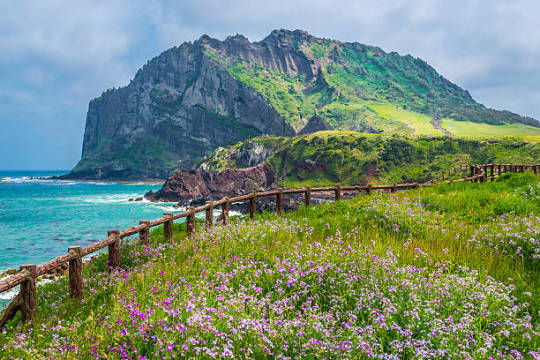
Jeju sland lies in the Korea Strait, south of the Korean Peninsula, and South Jeolla Province. It is located 82.8 km (51.4 mi) off the nearest point on the peninsula.
My dream destination is Jeju Island in South Korea. I am captivated by its stunning landscapes, cultural heritage, and exciting attractions. From beautiful mountains and waterfalls to unique experiences like staying in traditional homes and observing haenyeo divers, Jeju Island offers a memorable journey. I am eager to explore its natural beauty, immerse myself in the local culture, and indulge in delicious food. Jeju Island is my ultimate dream destination, full of adventure, charm, and relaxation.
I've done some research out of eagerness and curiosity about Jeju Island and its History. Based on my research, Jeju Island, also known as Jeju-do, is a beautiful island located off the southern coast of the Korean Peninsula. The history of Jeju Island is as fascinating as it is diverse. It has been inhabited for thousands of years and has its own distinct culture and traditions. Jeju Island was historically a separate province from mainland Korea, and its isolation allowed for the development of unique customs and beliefs.
One significant event in Jeju Island's history is the 4.3 Jeju Uprising, which occurred in 1948-1949. This uprising was a result of political tensions between local residents and the South Korean government. It led to a tragic period of violence and repression, leaving a lasting impact on the island and its people. The people of Jeju Island are called Jeju people or Jejuans. They have a distinct dialect and cultural practices that differentiate them from mainland Koreans. Jeju people have a deep connection to their natural environment and place a strong emphasis on preserving their traditions and heritage.
Just like here in my place Dumaguete City in Philippines, Jeju Island has a distinct culture that sets it apart from mainland South Korea. The island's culture is heavily influenced by its geographical isolation and the historical background of its inhabitants. The Jeju people, known as Jeju Islanders or Jejuans, have their own dialect called Jeju language or Jejueo. This language has been recognized as an endangered language by UNESCO.
The traditional lifestyle of Jeju Islanders revolves around farming, fishing, and diving. Due to the volcanic soil on the island, agriculture plays a significant role in their livelihoods. The cultivation of tangerines, barley, and other crops is prevalent. Fishing and diving are also important economic activities due to the island's abundant marine resources.
Jeju Island has preserved many unique traditions over the years. One notable tradition is the "Haenyeo" culture, which refers to female divers who collect seafood without using any breathing apparatus. These women have been an integral part of Jeju's history and culture for centuries. The Haenyeo were recognized by UNESCO as an Intangible Cultural Heritage of Humanity in 2016.
Another tradition is the "Dol Hareubang," which translates to "stone grandfather." These iconic stone statues can be found throughout the island and are considered to be guardians against evil spirits. They are often seen wearing a hat called "Bokgeon," which symbolizes fertility and protection.
Jeju Island hosts various festivals throughout the year that showcase its vibrant culture and traditions. One of the most famous festivals is the "Jeju Fire Festival," held in March. This festival celebrates the island's volcanic heritage and features fire-related performances, fireworks, and traditional music.
The "Jeju Haenyeo Festival" is another significant event that honors the Haenyeo culture. It takes place in April and includes various activities such as diving demonstrations, folk performances, and exhibitions.
Additionally, the "Jeju Olle Walking Festival" attracts hikers from around the world. It offers participants the opportunity to explore the island's scenic routes known as "Olle Trails" while enjoying cultural performances and local cuisine.
Jeju Island has a mild oceanic climate with four distinct seasons. Summers are warm and humid, with temperatures ranging from 23°C to 30°C (73°F to 86°F). Spring and autumn are pleasant, with temperatures averaging between 10°C and 20°C (50°F to 68°F). Winters are relatively mild compared to mainland South Korea, with temperatures ranging from 3°C to 10°C (37°F to 50°F).
The island experiences a significant amount of rainfall throughout the year, with the wettest months being June to August. Typhoons occasionally affect Jeju Island during the summer and early autumn months.
There are several ways to reach Jeju Island. The most common method is by air through Jeju International Airport, which has direct flights from major cities in South Korea as well as international destinations such as China, Japan, and Taiwan. Alternatively, visitors can take a ferry from various ports on the mainland, including Incheon, Mokpo, and Busan. The ferry journey typically takes several hours depending on the departure point.Once on the island, public transportation options include buses and taxis. Jeju Island also offers rental car services for those who prefer to explore at their own pace.
When visiting Jeju Island, l know that it is important to be aware of the rules and regulations in place to preserve the island's natural beauty and cultural heritage. Some key regulations include:
1. Environmental Protection: Visitors are expected to respect the island's natural environment by not littering, damaging flora or fauna, or engaging in activities that may harm the ecosystem.
2. Cultural Respect: It is essential to respect the local culture and traditions of Jeju Islanders. This includes following etiquette guidelines, such as removing shoes when entering traditional houses or sacred sites.
3. Haenyeo Diving: If you encounter Haenyeo divers during your visit, it is important to maintain a respectful distance and avoid interfering with their work.
Like you I'm also wondering how much money will it cost in going to Jeju Island in South Korea, and to determine the total amount of Philippine money that will be spent on a trip from the Philippines to Jeju Island in Korea, including transportation fees, accommodation, food, budget, meals, and souvenirs, it is important to consider various factors such as travel expenses, accommodation options, dining choices, and shopping preferences. Please note that the actual costs may vary depending on individual preferences and circumstances.
The transportation fees for a trip from the Philippines to Jeju Island will depend on several factors such as the mode of transportation chosen (airplane or ferry), the time of booking, and the season. The most common way to reach Jeju Island from the Philippines is by taking a flight. The cost of airfare can vary significantly based on factors such as airline choice, departure city in the Philippines, and travel dates. It is recommended to compare prices across different airlines and book in advance to secure better deals.
Jeju Island offers a wide range of accommodation options catering to different budgets. The cost of accommodation will depend on factors such as location, hotel rating, amenities offered, and travel season. Jeju City and Seogwipo are popular areas for tourists to stay. Budget travelers can find affordable guesthouses or hostels starting from around PHP 1,000 per night. Mid-range hotels typically range from PHP 2,500 to PHP 5,000 per night. Luxury resorts and high-end hotels can cost upwards of PHP 10,000 per night.
The cost of food in Jeju Island can vary depending on personal preferences and dining choices. There are various options available ranging from street food stalls to local restaurants and international cuisines. On average, a meal at a local restaurant can cost around PHP 300 to PHP 500 per person. Street food items are generally more affordable, with prices ranging from PHP 50 to PHP 150 per item. It is also worth noting that self-catering by purchasing groceries from local markets or convenience stores can help reduce food expenses.
In addition to transportation, accommodation, and food, it is essential to allocate a budget for miscellaneous expenses such as entrance fees to attractions, local transportation within Jeju Island, shopping, and souvenirs. Entrance fees for popular attractions like Jeju Loveland or Jeju Folk Village can range from PHP 200 to PHP 500 per person. Local transportation options include buses, taxis, or renting a car. Budgeting around PHP 500 to PHP 1,000 per day for miscellaneous expenses would be a reasonable estimate.
The cost of souvenirs will depend on personal preferences and the items chosen. Jeju Island offers a variety of unique souvenirs such as traditional crafts, cosmetics, tea, and local delicacies. Prices can range from a few hundred pesos to several thousand pesos per item. It is advisable to set aside a specific budget for souvenirs based on individual preferences.
Can't wait to be in Jeju Island in South Korea.
Hope to visit and explore this place with you.
REFERENCES:
- Kang, W. (2012). Jeju Island: Visions and realities of a distinctive geotourism destination. GeoJournal, 77(1), 7-20.
-Lee, K. (2013). Jeju dialect as a metaphorical language: A cultural interpretation. Language and Linguistics, 14(6), 921-944.
-The official website of the Department of Tourism in the Philippines provides information on travel destinations, tips, and guides.(n.d.). Department of Tourism - Philippines . Retrieved from http://tourism.gov.ph/news_features/FilipinoBrandofService.aspx
-The official website of the Korea Tourism Organization offers comprehensive information about traveling to Korea, including Jeju Island.(n.d.). Visit Korea. Retrieved from https://english.visitkorea.or.kr/svc/contents/infoHtmlView.do?vcontsId=136644
-A popular travel website that provides user-generated reviews and recommendations for accommodations, restaurants, attractions, and more.(n.d.). TripAdvisor. Retrieved from https://www.tripadvisor.com.ph/
-Official website of the United Nations Educational, Scientific and Cultural Organization provides information on Jeju Island's cultural heritage.(n.d.). UNESCO. Retrieved from https://en.unesco.org/global-geoparks/jeju-island
-Official website of the Korea Tourism Organization.(n.d.). Visit Korea. Retrieved from https://english.visitkorea.or.kr/
Curley, R. ( 2018, March 21). Busiest air route in the world revealed . Business Traveller. Retrieved fromhttps://www.businesstraveller.com/business-travel/2018/03/21/busiest-air-route-world-revealed/
3 notes
·
View notes
Text


A couple photos of Columnar (Hexagonal) Joints at Jungmun Daepo Coast, Jeju (Island), South Korea. It was a beautiful sight to see in my time there.
They were created by Basaltic lava, erupting from the then active Hella-san, interacting with the sea somewhere around 900°C( 1652°F).

Got to meet this cool guy. This is a recreation of the “Dol hareubang”, in the Jeju dialect meaning, “grandfather made out of stone”. These stone sculptures/statues were made by the original native population, carved out of basaltic rocks.
11 notes
·
View notes
Text
Travel tourist
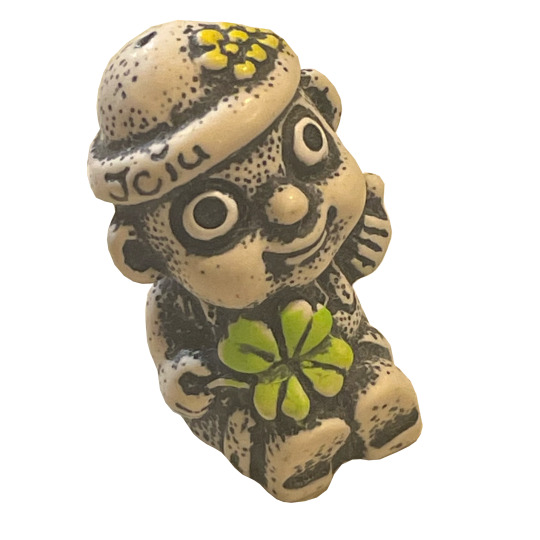
EXPLAIN THE ORIGIN OF THE ELEMENT:
This is a tourist souvenir based on the iconic Stone Grandpa of Jeju Island, South Korea. The Stone grandpa is called ‘Dol hareubang’ ,is a type of large rock statue found on Jeju Island off the southern tip of South Korea.
WHERE DID YOU GET THIS ELEMENT FROM?
This is my first time traveling abroad with my family ,my mother bought me a travel souvenir.
WHY IS THE ELEMENT SIGNIFICANT TO YOU?
This element is significant to me, because of it captures the memory of special journey with my famliy. the four-leaf clover held by the Dol hareubang symbolizes luck.This symbolism can inspire me to approach life with an optimistic and lucky mindset.
HOW IS THIS ELEMENT SIGNIFICANT TO YOUR CREATIVITY?
It remind the emotions, laughter, and bonding that occurred during my family trip. As such, it holds a special place in my heart, which can be a source of inspiration for creative projects that evoke sentiment and nostalgia.And also i think the souvenir can shows the idea of different cultural diversity. It shows how different parts of the world have unique symbols, traditions, and culturea. This diversity can inspire to explore and incorporate various cultural elements in my creative.
0 notes
Text

Our Elders Enshrine the Ancestors as Jangseung and Dol Hareubang
the jangseung 장승 totem poles of Korea and the dol hareubang 돌 하르방 lava rock statues of Jeju are village guardians carved into humorous and terrifying caricatures of grandparents or folk deities. They are often placed on the outskirts of town near the sinmok 신목, a sacred tree (usually a zelkova serrata, Korean pine, or ginkgo biloba) with a sotdae 솟대 (carved duck on a pole) pointing away from the village to ward off ill-fortune, disease, and unwanted visitors.
1 note
·
View note
Photo
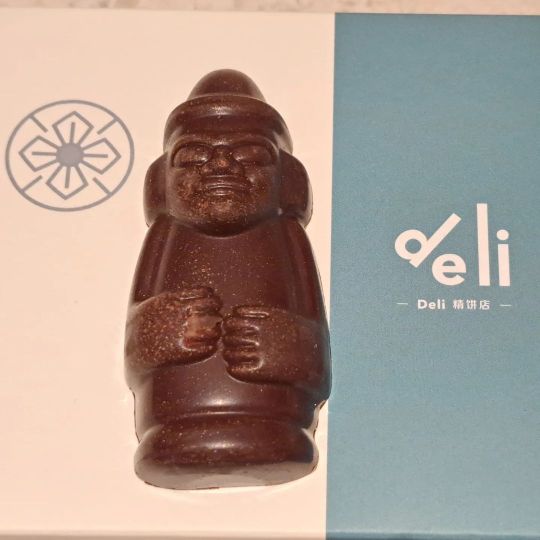
Dol Hareubang Chocolate filled with Caramel - Deli Grand Hyatt Jeju😃#thetravellinggourmet #gourmetsansfrontieres #dolhareubang #jeju # deligrandhyattjeju #grandhyattjeju #deli https://www.instagram.com/p/CirtD55LgUDuqopf_tgZOcVgdLlYXEEIGMpfh80/?igshid=NGJjMDIxMWI=
0 notes
Text
Melancong ke Korea Selatan
Bagian 4 Mukbang
Masih di Pulau Jeju, memasuki restoran halal all you can eat incaran, kami langsung disambut dengan dua patung kayu bentuk dol hareubang khas pulau ini. Pemilik toko pun langsung bergegas menyambut kami. Kami yang masih bersemangat, mengambil gambar bagian depan toko yang unik ini, dengan tidak lupa mengambil magnet gratis bergambar pantai berbatu Pulau Jeju di senja hari. Magnet yang sederhana, hanya berbentuk persegi, tapi cukup menarik, mungkin karena gratis.
Masuklah kami lebih dalam ke restoran tersebut. Di sebelah kanan terdapat ruangan tanpa sekat, tampak meja-meja khas prasmanan. Di tengah ruangan meja panjang berisi kuali-kuali tertutup entah apa isinya (pastinya makanan). Lemari-lemari pendingin mengitari meja tersebut. Terlihat ada bagian makanan laut, ada pula bagian daging yang tertata rapi. Sekilas memandang, kami buru-buru menuju tempat duduk kami. Restoran tersebut kosong, mungkin karena waktu kami datang bukan jam makan. Sudah sangat terlambat untuk makan siang, tapi masih belum waktunya makan malam. Beban-beban yang kami tenteng segera kami letakkan dengan rapi di pojokan, bersiap-siap makan. Di tengah meja kami terdapat kotak yang terbagi menjadi dua. Tapi tunggu, apa yang harus kami lakukan setelah ini? langsung makan? bagaimana peraturannya?
Belum sempat terlihat bingung, pelayan restoran sudah menghampiri kami. Beliau menjelaskan bahwa kami bisa memilih dua jenis kuah yang nantinya akan dimasukkan ke dua bagian kotak tadi dan dipanaskan. Pilihannya ada kuah makanan laut, kuah biasa, dan kuah pedas. Karena kami ingin memakan makanan laut juga kami pilihlah kuah makanan laut, dan untuk dagingnya kami pilih kuah pedas (walaupun pada akhirnya bersatu padu juga). Sambil menunggu kuah, berjelajahlah kami menuju ruangan berisi makanan tadi. Dengan sigap membuka satu-persatu kuali yang ada di meja tengah, ternyata meja tersebut berisi makanan-makanan yang sudah matang, seperti pasta, tempura, jagung, dan banyak lagi. Kami pun menemukan makanan serupa di meja yang mengitarinya. Kami ambilah makanan yang menarik buat kami. Mengingat tujuan utama kami adalah makan shabu-shabu, maka kami sedikit menahan diri. Setelah piring sedikit terisi, kami kembali ke meja dan mulai memakan makanan tersebut (pemanasan sebelum kuahnya datang). Makanan sudah menipis, kuah pun datang. Kami masih harus menunggu kuah tersebut panas. Kembalilah kami ke ruangan tadi untuk mengambil bahan mentah.
Saya mengambil sepiring makanan laut yang segar. Gurita kecil, udang, dan tentu saja yang sangat saya nantikan adalah abalone. Waktu itu saya belum pernah mencoba yang namanya abalone, hanya menonton saja dari acara variety show favorit saya. Sengaja saya mengambil abalone lebih banyak daripada makanan laut lainnya. Walaupun tidak sebesar yang di televisi, tapi abalone ini masih sangat segar, mereka terlihat masih bergerak. Walaupun kenampakannya agak mengerikan, tapi entah kenapa air liur saya mulai menetes membayangkan kekenyalan abalone tersebut dipadu dengan kuah nikmat khas Korea. Setelah sepiring makanan laut aman sampai meja makan, saya kembali lagi ke ruangan tersebut untuk mengambil berbagai macam daging.
Daging-daging ditaruh pada semacam kotak kayu. Tampak sekali daging-daging tersebut dari bagian tubuh yang berbeda-beda. Tapi saya yang buta jenis daging langsung saja membawa yang menurut saya terlihat enak. Lembaran-lembaran tipis tersusun rapi di dalam kotak. Beberapa kotak daging berhasil kami amankan ke meja kami. Tepat setelah perburuan usai, kuah nampak menunjukkan tanda-tanda akan mendidih. Semakin tidak sabar kami segera ingin menyantap hidangan ini.
Saat kami mulai akan makan, beberapa tamu nampak berdatangan. Dua kelompok, sepasang muda mudi dan sebuah keluarga kecil. Tanpa sempat memperhatikan lebih lanjut kamipun mencemplungkan bahan-bahan mentah tadi ke dalam kuah setelah terlihat mendidih sempurna. Kami lanjut memakan hidangan tersebut dengan lahap. Tak terhitung berapa kali kami bolak balik ruangan untuk mengisi lagi kuali kuah kami dengan daging, makanan laut, dan sedikit sayuran. Kami pun sempat minta isi ulang kuah yang menyebabkan percampuran berbagai jenis kuah tak terelakkan. Beruntung tidak ada biaya tambahan apapun. Selama kurang-lebih dua jam kamipun selesai dengan perut sangat kenyang. Sejenak menurunkan beban perut, kami memutuskan segera ke penginapan.
0 notes
Photo
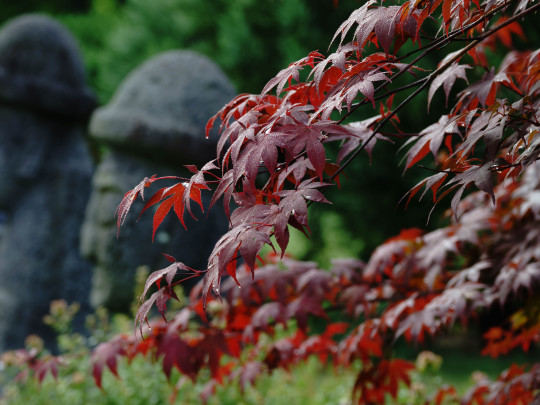
photo: David Castenson
#japanese maple#jeju dol hareubang#korean garden#meadowlark botanical gardens#photographers on tumblr
202 notes
·
View notes
Photo
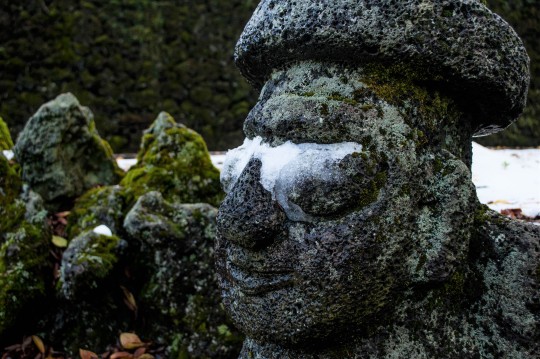
Snowbrows
Jeju, November 2015
#photographers on tumblr#original photography#photography#jeju#jejudo#jeju island#korea#south korea#dol hareubang#statue#snow#basalt#moss#winter
30 notes
·
View notes
Text
Interesting points on Haru of Chakho
So I saw an army point out on twitter that on Jeju Island, there are rocks called Dol hareubang, also called tol harubangs, hareubangs, or harubangs, are large rock statues found on Jeju Island off the southern tip of South Korea. They are considered to be gods offering both protection and fertility and were placed outside of gates for protection against demons traveling between realities. [According to Wiki ]
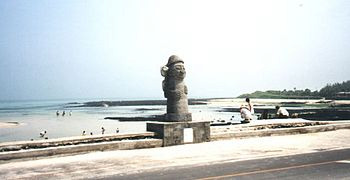
(A dol hareubang at Hyeopjae Beach on Jeju Island)
And we know by Jimin that his character HARU was formerly a “rock deity” that guarded the entrance to the World of Beom, who is turned into a “human” in order to hunt down Beom who’ve crossed over to the human world to cause harm.
And you know what else I immediately thought of when I heard this background story? Of this really old anime I saw when I was like 10 called: “ZENKI: The Demon Prince”.
(ZENKI’s plot had to do with this warrior/demon/guardian that was sealed into stone by the Great Priest Ozuno and those of his lineage would inherit the power to control ZENKI and summon him from his slumber some day when danger and chaos happen in the world due to the “seeds of evil” or “seeds of Karuma” )

So with Chiaki/Cherry’s help (who is direct descendant of Ozuno), Zenki is freed from his stone prison so to speak. But despite being freed, Zenki manifests in the body of a child and in order to reach his true form, Chiaki has to perform an incantation each time (also using a special bracelet gifted to her by her grandmother).
But I wonder what could’ve awakened HARU into a human form despite not really being human himself. And if he really has lived so long as a deity, is that why in the snippets that Hybe shared Jimin tells JK that he saw him grow up and remembers when JK would pick up flowers...
So for all the UNCULTURED armys out there who were talking shit and dragging Jimin’s character on twitter. NO, Haru isnt "just a boring rock who turned into a guy", while all the other characters had "more tragic/interesting background stories" (except Jooan, he just has a predicament of having fallen in love with a demon/beom... which I’m still having trouble digesting because aren’t beom shown to be Demon Tiger entities? How does one just “fall in love/has a forbidden relationship” with one? Did they take human form?).
Even the members themselves said during his interview that it meant HARU was an important character.
#HARU_JIMIN#Haru of Chakho#jimin#bts#7 fates chakho#7 FATES#CHAKHO#park jimin#bts jimin#bantansonyeondan#PJM#pjms
16 notes
·
View notes
Text
event: scavenger hunt
On the morning of the first day of March, a new poster hangs by the front entrance. It shows slight signs of wear, evidently having been used again and again for the same purpose. Sunyoung’s handwriting appears beneath a cluster of Jeju-themed stickers. It reads:
“Keep on seeking, and you will find...We’ve hidden our beloved dol hareubang figurines in the house, outside, and around town (you’ll know it’s ours by the orange flowers in their hands). There are 5 figurines in total. Please take a picture with them when you find them, and show us once you’ve completed your search! You might be in for a treat ^^ Good luck!”
Below the text, a printed map has been decorated with sticky notes that show how many figurines are at each location-- two near Homestay, two by local businesses, and one by the beach. They’re accompanied by photos that show their approximate positions.
Welcome to our first event-- Homestay’s annual scavenger hunt! This event is optional, but it is highly encouraged that you participate. In ic time, it will be a one-day event; ooc, it will continue until someone successfully completes the task. As with all Homestay events, both guests and locals are welcome to join in. Your muse can complete this challenge alone, or with a friend (or as a team). Please tag relevant threads #hs:scavhunt. We’ll leave the answers below. Have fun!
Answers:
1. By the garden, behind the watering can
2. Out by the patio, beneath the porch swing
3. On the bench in front of The Islander
4. Next to the cash register inside the unnamed restaurant
5. Atop the bridge at Hamdeok beach
#hs:event#this was meant to be posted on the first but we've been running a bit behind schedule! forgive us ^^;
7 notes
·
View notes
Text
🇰🇷Curiosities about Korean Culture #2🇰🇷
안녕! Hello! Hola! Ciao! Salut! Hallo!你好! こんにちは! Today I’m here with a new blog about curiosities about Korean culture! Hope you’ll like it! So, let’s start!
-The microchips for Apple’s iPhones are made by the South Korean company Samsung.
●○●○●○●○●○●○●○●○
-On Jeju, South Korea’s largest island, giant stone statues known as dol hareubang (old grandfather) can be found along the beaches. Newlywed women believe that if they touch the statues’ long, broad, phallic-looking noses, they will be blessed with fertility.
●○●○●○●○●○●○●○●○
-More than 2 billion people have viewed the “Gangnam Style” music video of Korean K-pop artist Psy since 2011. It topped the charts in 30 countries around the world. World leaders including U.S. President Barack Obama and British Prime Minister David Cameron have mimicked the dance. The song refers to the Gangnam District of Seoul.
●○●○●○●○●○●○●○●○
-Along with Tokyo residents, Seoulites get the least amount of sleep of any residents of major cities in the world, just fewer than 6 hours a night.
●○●○●○●○●○●○●○●○
-South Koreans enjoy showing off their relationship statuses publically. It is common to see couples holding hands, kissing, and even wearing matching outfits.
●○●○●○●○●○●○●○●○
-Playing the online video game StarCraft is a legitimate career in South Korea. Since the game launched in 1998, nearly half of all the games have been sold in South Korea.
●○●○●○●○●○●○●○●○
-The South Korean National Information Agency estimates that 14% of the people between the ages of 9 and 12 have an Internet addiction. In 2011, South Korea passed a law called the Shutdown, or Cinderella, Law that bans anyone younger than 16 from online game sites, which is largely ignored by the youth.
●○●○●○●○●○●○●○●○
-Few South Koreans choose not to marry, and an unmarried person is called a “Big Baby” in Korean slang. There are two-way kinds of marriage in South Korea: yonae (love marriage) and chungmae (arranged marriage).
●○●○●○●○●○●○●○●○
-Some people in Korea, especially elders in the countryside do not like having their photos taken. So it’s best to ask permission or avoid taking the photo to avoid giving offense. You also should avoid photographing anything that looks like it could be used for military purposes.
●○●○●○●���●○●○●○●○
-The use of the word ‘friend’ in Korean is actually quite complex! The term can be used much like ‘brother’ or ‘sister’ are used in Korea.
●○●○●○●○●○●○●○●○
-Koreans love reading newspapers. They have 63 daily editions in print.
●○●○●○●○●○●○●○●○
-Everything closes late, with most stores open until at least 11:00 p.m. Restaurants, cafes, bars, and street food vendors stay open even later, sometimes until 4 a.m.
●○●○●○●○●○●○●○●○
-Taekwondo is the national sport and is everywhere in Korea. There is a school in every town.
●○●○●○●○●○●○●○●○
-You can easily travel around South Korea by high-speed trains, bus routes, ferry services, and airports. High-speed trains connect the major cities such as Seoul, Busan, Incheon, Daegu, Daejeon, and Gwangju.
●○●○●○●○●○●○●○●○
-Fruit is really expensive in the country. A watermelon will set you back about 30,000 won, about US$25
Like💗 or Reblog if it was useful♻️
Do not Copy📝or Repost📌
。・:*:・゚★,。・:*:・
Have a Good Day
。・:*:・゚★,。・:*:・゚

Via- www.tumblr.com/blog/innateinsomniac
#korean star#korean style#korean drama#kanji#south korea#kpop#korean#kyoto#kik#bts scenarios#bangtan#beyond the scene#busan international film festival#bts#blogger#bangtan boys#study tips#stunning#student#studying#studio#studylbr#exo#exchange#aesthetic landscape#korean language#language#exo k#red velvet#red carpet
539 notes
·
View notes
Photo

When traveling to Jeju Island, one is greeted by many of these statues throughout the island. Called ‘dol hareubangs’, or ‘old grandfathers’, the statues are carved of volcanic rock and are gods that offer both protection and fertility. (at Jeju Island)
4 notes
·
View notes
Text
South Korea Day 01 Part 2/2 (5th Nov)
After going to the Namsam Tower, we head to Gyeongbokgung – the main royal palace of the Joseon Dynasty and was built in 1395!! But before we actually head towards the palace, we went to rent some Hanbok which is the traditional Korean costume. The rental was included in the tour so thats easy for us once again. Hanbok has so many colours it was actually hard to choose from, me and sis said to wear something similar, in fact she actually chose the one that I wore and she has got great taste as seen from the photos. Koreans still wear Hanbok on special occasion these days, very much like the Japanese wearing their Kimonos.
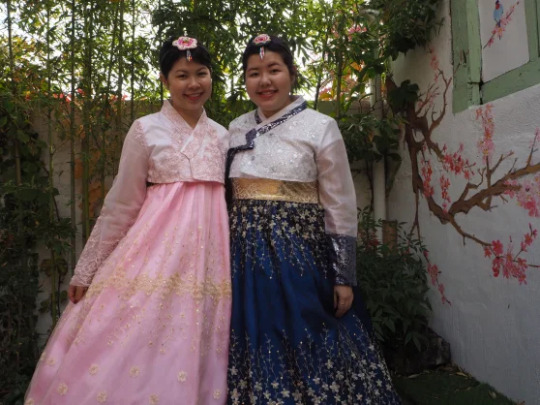


Family shot before leaving the rental shop
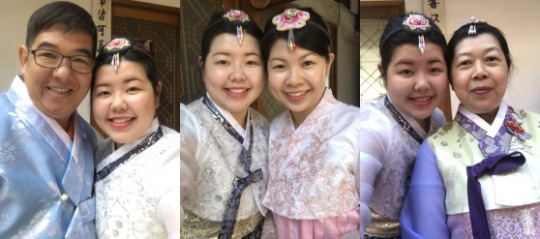



while walking towards the palace
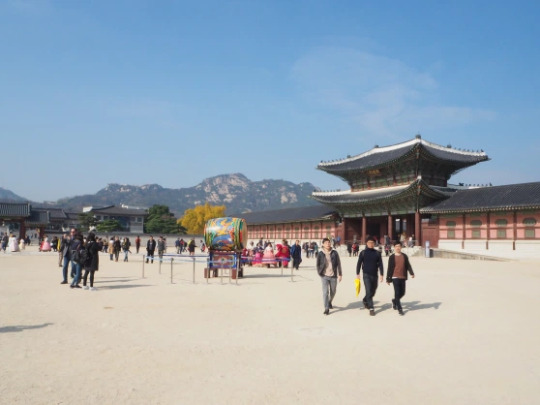
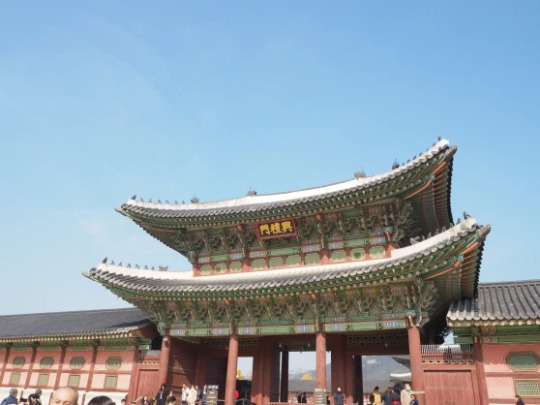
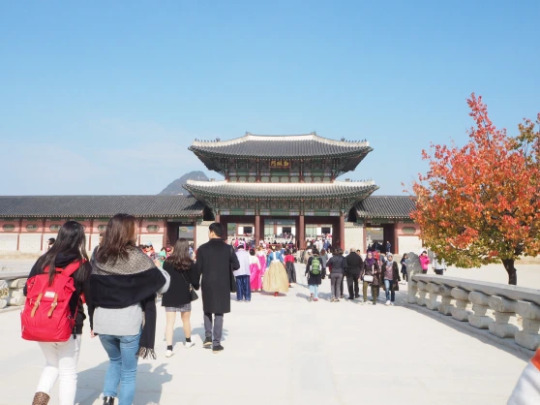

Very amazed to think people from the past built impressive buildings like these, and the intricate design, colours and everything.
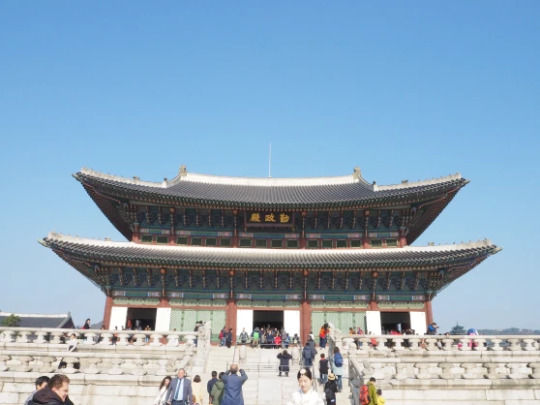

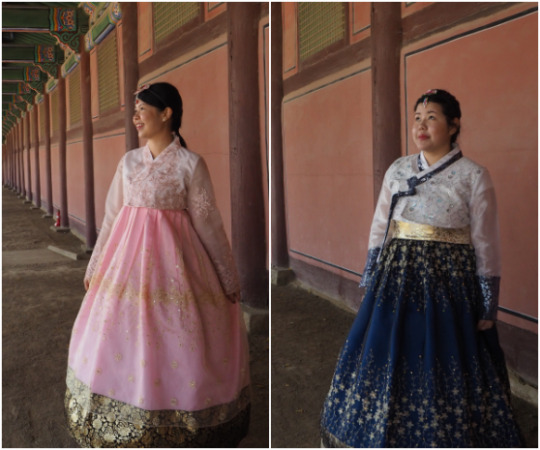
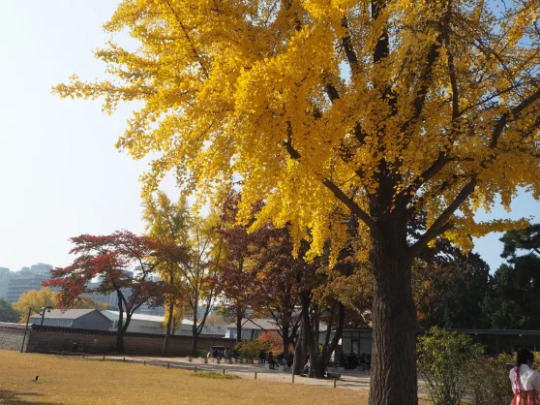
Don’t you love the colours of the tree leaves!?



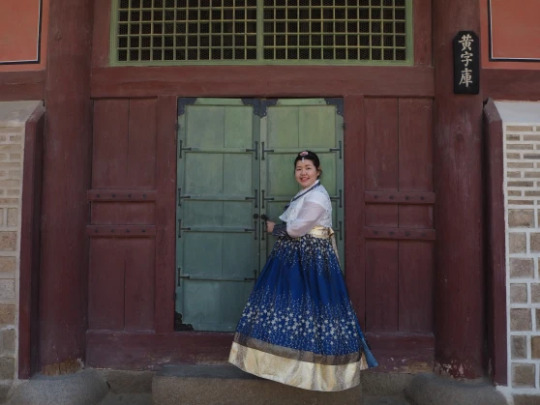
^ So we found this plaque that has got our last name on it “Huang” so we were a little too excited and of course we had to take a shot with it, right?!
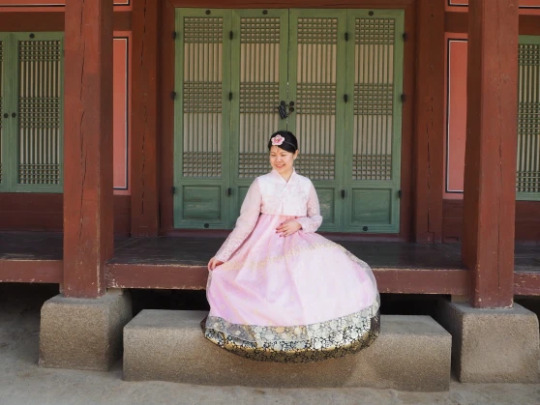
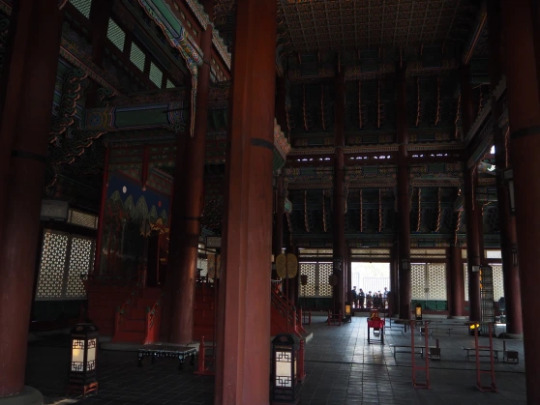
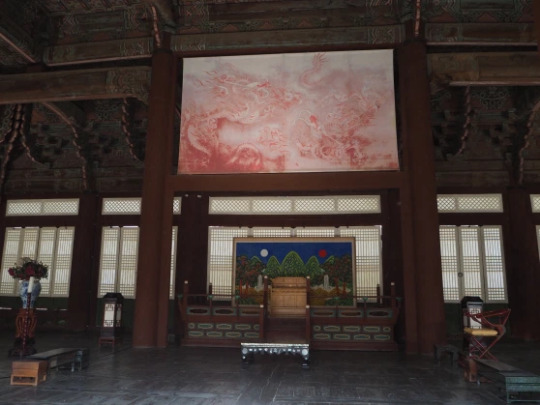
^ Inside one of the hall, and in the middle – there’s where the King sits.

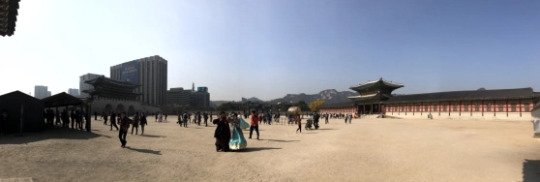
Pano shot outside the palace.

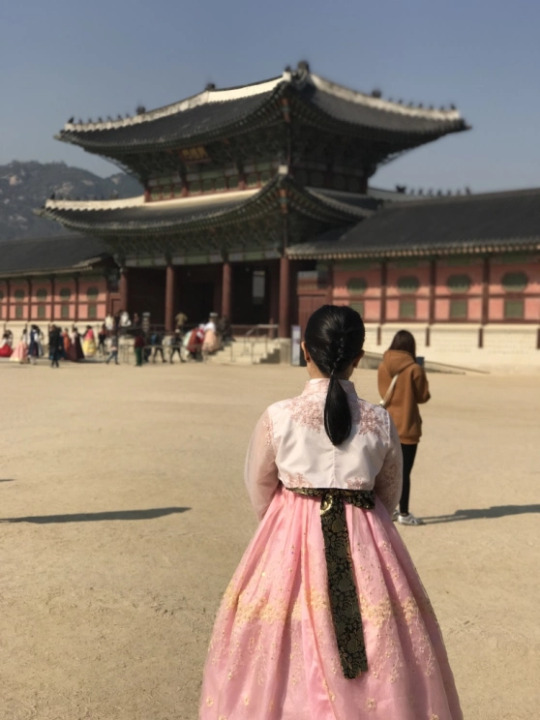
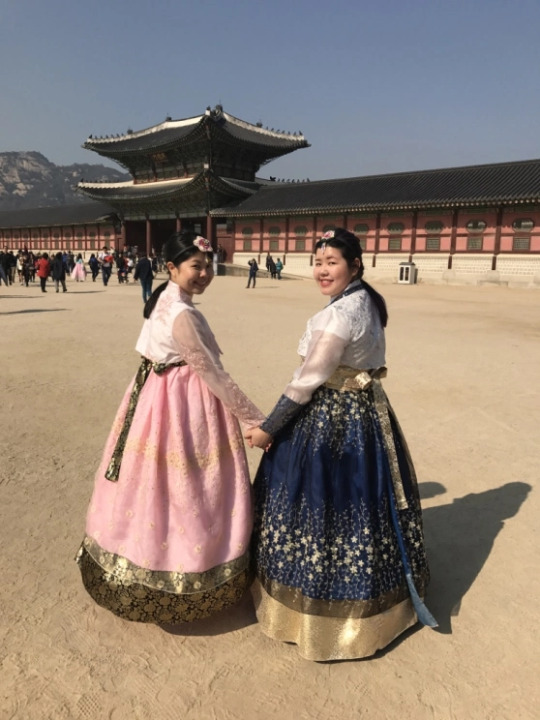
^ Fav picture of the day

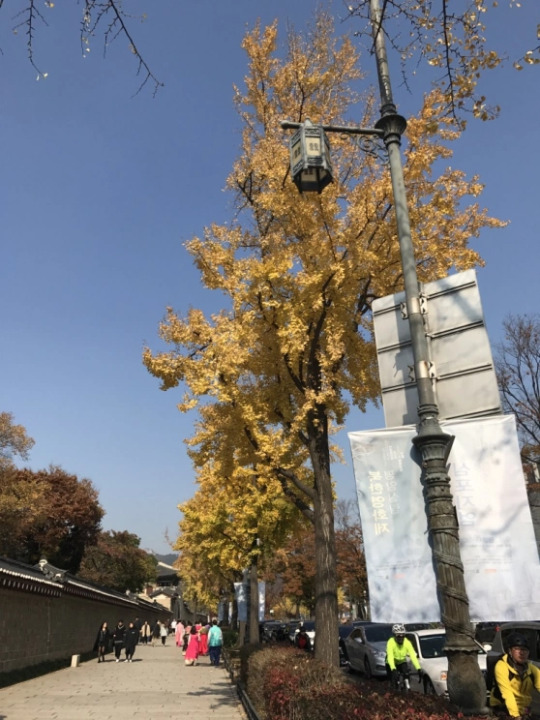
along the street~ what a view that’s rare in Singapore

After returning the Hanbok, going to lunch, we took a domestic flight to Jeju and we went to the Yongduam Rock (Dragon Head Rock) – as the name suggest, the rock looks like a dragon head. BUT, it really only look like one from far, and we were pretty upclose, and I heard its nicer in the morning. So yeah.


^ Does it look like anything at all really?
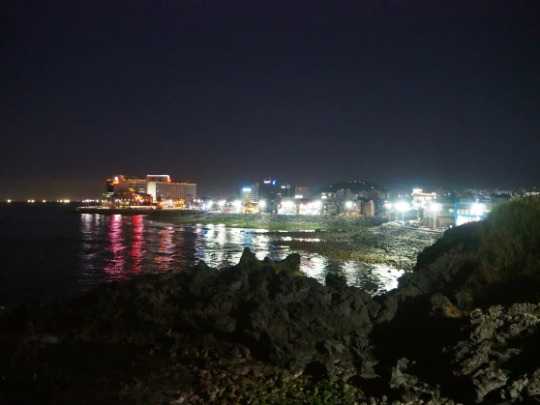
On a side note, lovely sea view

Us with the famous Jeju Dol hareubang that are actually rock statue that are scattered around Jeju and are considered to be God to provide protection.


^ Tangerine season in Jeju so you see loads and loads of tangerine everywhere!

Dinner was typical (well I wouldn’t quite say this is typical but that’s what the tour guide said) Korean cuisine. And I finally understand why Koreans love their rice so much because honestly tho, the rice just tasted so different! Even I loved it and y’all know I don’t really eat that much rice, so that sure shows something!
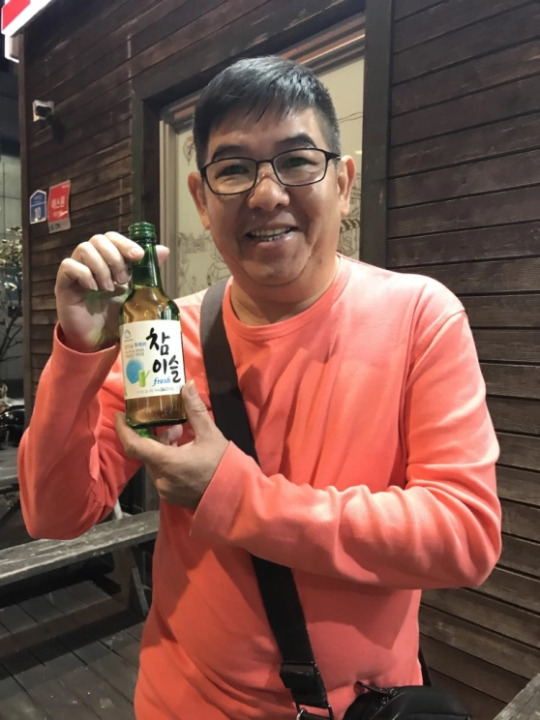
^ Had an early check in to the hotel, but we went around checking out the surroundings, got ourselves some Soju (Korean’s alcohol) and this just smells like the ethanol I use in lab because of how high the alcohol concentration is, but Koreans love this, and its really cheap, like only $1 plus? Less than $2, that’s REALLY cheap!
And so our first day sure felt extra long, travelling from Sg to Incheon, and then to Jeju, but at least we all had a really good time, and the weather was amazing too, the hotel was great as well. Nothing to complain really! x
0 notes
Text
5-Day Jeju Itinerary: Places to Visit
This post is part 1 of a 3-part Jeju guide series. I will focus on the places to visit in Jeju. Read my second post in this series for a Jeju Food Guide and my third post if you want to see our Udo Island itinerary. *Special thanks to my friend George who did a lot of the planning for this trip!
Day 1: Jungmun
Transport from Jeju Airport to Jungmun
Take Bus 600 from the Airport Bus Stop (제주국제공항) to Jungmun Tourist Complex (9 stops; approximately 1 hour). We paid ₩18000 for 4 people.
Museums in Jungmun
(1) Teddy Bear Museum (테디베어박물관)
The Jeju Teddy Bear Museum is filled with (mostly) cute and (a few) creepy teddy bears. One of the more amusing exhibits is the Teddy Bear version of Michelangelo’s “Creation of Adam” (pictured below). The museum contains two galleries, a museum gift shop, a cafe, a movie theatre and a teddy bear garden. The teddy bear garden is very heart-warming - it is well-decorated and filed with adorable life-sized bears that you can pose next to. Also look out for the 9-ft teddy bear at the entrance of the garden.


Walking through this museum was especially nostalgic for me because I visited the museum with my family more than 10 years ago, and I can still remember many of the exhibits. While I am having a lot of fun living overseas, once in a while I still miss home and my family a lot :’(
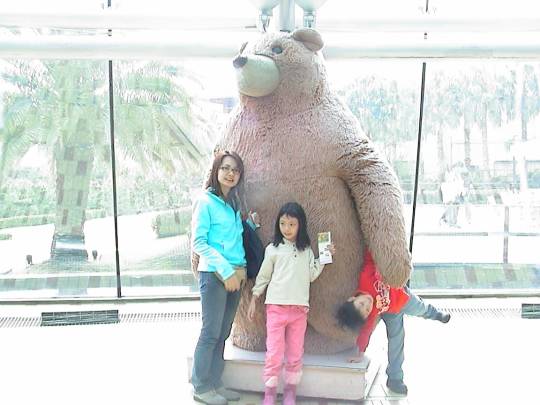
Cost: ₩10000 (₩ 8,800 if you book on Klook)
Opening Hours: 09:00-19:00 (last entry at 18:00)
Suggested Duration: 2 hours
Address: 31, Jungmungwangwang-ro110beon-gil, Seogwipo-si, Jeju-do 제주특별자치도 서귀포시 중문관광로110번길 31 (색달동)
Special Features: The museum has lockers near its entrance for smaller bags (small fee required). You can also store your larger luggage bags for free (ironically) behind the front desk.
(2) Chocolate Museum
The Chocolate Museum is a 10-minute walk from the Teddy Bear Museum. Many of the TripAdvisor reviews say that visiting this museum is a waste of time. I don’t disagree. However, we paired our visit with a macaron decorating class, which made it slightly more interesting.
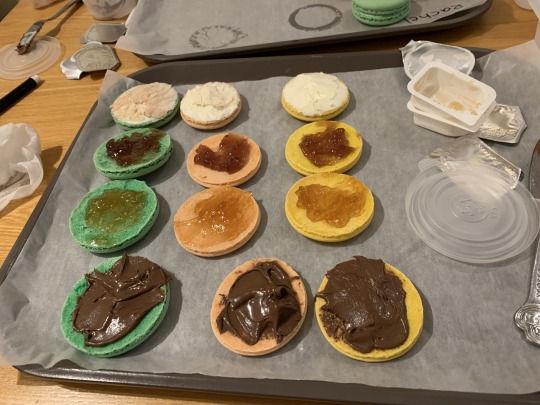
Cost: ₩12000 (includes costs for both entrance fee and macaron decorating class)
Opening Hours: 10:30-18:00
Suggested Duration: 10 minutes (touring the museum) + 1 hour (macaron decorating class)
Address: 551-18, Ilgwa-ri, Daejeong-eup, Seogwipo, Jeju Island 699-932, South Korea
(3) Other museums in Jungmun that we did not visit: Alive Museum, Play KPOP
Day 2: Hallasan and Seogwipo
Hiking Hallasan (한라산국립공원)
We travelled to Hallasan from Jungmun city by taxi. This costed us ₩23000. You can easily call a taxi using the Kakao Taxi App.
Possible Hiking Trials
(1) Yeongsil Trail: 5.8km
Yeongsil Rest Stop - Byeongpungbawi Rock - Uitse Oreum - Nambyeok Point
(2) Gwaneumsa Temple Trail: 8.7 km
Gwaneumsa Camping Site - Tamna Valley - Gaemideung - Samgakbong Peak Shelter - Summit (Dongneung)
(3) Seongpanak Trail: 9.6 km
Seongpanak Trail Information Center - Sokbat Shelter - Saraak Oreum Entrance - Azalea field - Summit (Dongneung)
(4) Donnaeko Trail: 7 km
Donnaeko Trail Information Center - Pyeonggue Shelter - Nambyeok Point
(5) Eoseungsaengak Trail: 1.3 km
Eorimok Trail Information Center - Eoseungsaengak
(6) Seokguram Trail: 1.5 km
Chunghon Memorial Site parking lot - Seokguram
The path we took was icy (we went in end November), but the views along the way were very pretty.
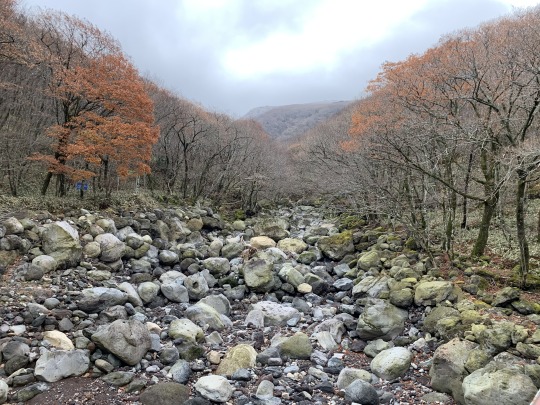
Cost: Free
Opening Hours: N/A
Address: 2070-61, 1100-ro, Jeju-si, Jeju-do 제주특별자치도 제주시 1100로 2070-61
Note: There are no bathrooms or shops during the course of the trial.
Dinner at Seogwipo Maeil Olleh Market
A taxi from Jungmun to the Seogwipo Maeil Olleh Market costed us ₩14800.
We tried an extensive array of street food at the Seogwipo Maeil Olleh Market, including tangerine mochi, crab sticks, beef cubes, spicy tteokbokki (rice cakes), cheesy squid pancakes peanut dumplings and peanut wine. Each item was priced at no more than ₩2000. Being someone who likes sweet desserts, my favourite was of course the tangerine mochi. The mochi not only was made of tangerine flavoured ice cream, but the ice cream also wrapped around an actual slice of tangerine.
Opening Hours: 07:00-21:00
Suggested Duration: 2.5 hours
Address: 22 Jungjeong-ro73beon-gil, Seogwi-dong, Seogwipo-si, Jeju-do, South Korea
Day 3: Seogwipo, West Coast of Jeju and Jeju City
We hired a private driver and car on HopeTrip to (i) take us from Seogwipo to Jeju City and (ii) tour the west coast of Jeju Island. The package we selected allowed us to be with our driver for 10 hours. We could tell our driver the places we wanted to visit as we went along. The price of hiring a private driver and car is relatively reasonable when split among 4 people. However, if you are travelling alone, a more cost-effective method of touring would be to join a group tour on Klook.
Horseback riding in Seogwipo
We started our morning with horseback riding at Jeju Land ATV & Horse Riding (제주랜드ATV&승마). The experience was pretty fun, but it lacked the “fear factor” element because the terrain was relatively flat and the route was fenced along its sides such that our horses could only go in one direction. Nevertheless, in exchange, the upside to this experience at Jeju Land was the high-level of safety it offered.

Cost: ₩50000 for 30 minutes
Opening Hours: 09:00-18:00 (last entry 17:00)
Address: 제주특별자치도 서귀포시 성산읍 서성일로 397
Tangerine picking in Seogwipo

Our driver recommended a tangerine picking place in Seogwipo. The tangerine farm was divided into two sides: sour tangerines and sweet tangerines. We were given gloves and clippers and could hand-pick our tangerines from the farm. There was no time limit, and we were allowed to eat as many tangerines as we wanted while we plucked them. At the end of the experience, we could each take home one bag of tangerines. There are also many photo spots near the entrance of the farm if you want to take Instagram pictures. 🍊
The price of this experience is very reasonable when compared to the price of tangerines we bought from the Seogwipo Maeil Olleh Market.
Cost: ₩6000
Osulloc Tea Museum
We travelled to the Osulloc Tea Museum by car. However, the museum is also accessible by public transport.
If you are heading here from Jeju city/Moseulpo, take Bus No.755 to OSULLOC station.
If you are heading here from Seogwipo city/Jungmun Tourist Complex, take Bus No.780, 961 to Dongkwang Yukkeori station. Transfer to bus No.755 and take the bus to OSULLOC station.
If you are heading here from Hallim, take Bus No. 967 to OSULLOC station.
At the Osulloc Cafe, we purchased a green tea dessert set. For ₩36000, we got (i) matcha cream cake, (ii) matcha ice cream, (iii) matcha smoothie and (iv) one tea pot of green tea. I am not usually a big fan of green tea and matcha flavoured products, but the green tea desserts at the Cafe were very tasty. The green tea cream cake in particular is very good!
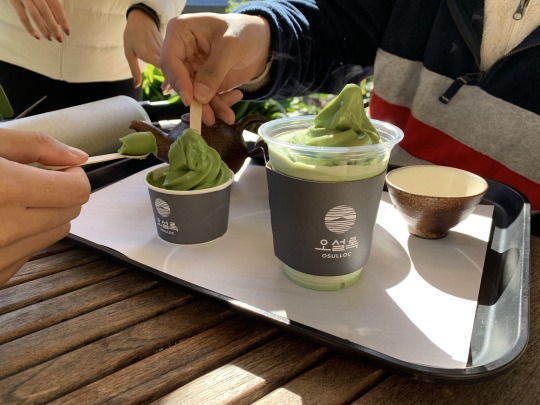
After enjoying matcha flavoured desserts at the cafe, head down to the green tea fields.
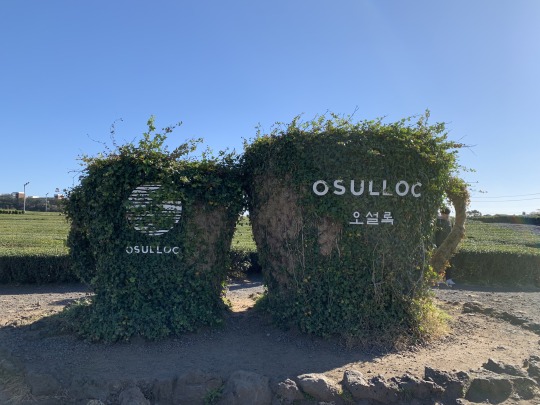
Cost: Free
Opening Hours: 09:00-18:00
Suggested Duration: 2 hours
Address: 15 Sinhwayeoksa-ro Andeok-myeon, Seogwipo city, Jeju-do
Hallim Park
Hallim Park has gardens that can be enjoyed in any season. Attractions include Palm Tree Road, Jeju Stone and Bonsai Garden, Water Garden, Subtropical Botanic Garden and many more. The most famous tourist sites in Hallim Park are the Hyeopjaegul and Ssangyonggul Caves. You can also check out the park’s folk village, where you will see sculptures of Jeju’s famous Dol hareubang.
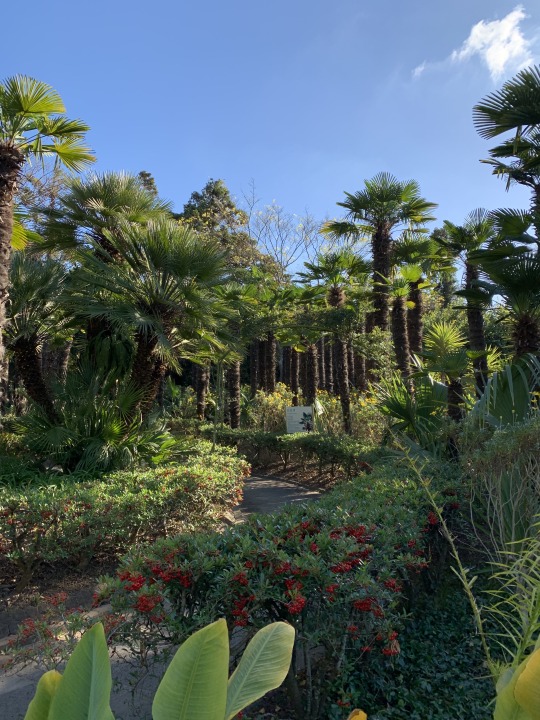
The Dol hareubang sculptures are carved from the island’s porous volcanic rock and are easily identifiable: they all have bulging, pupil-less eyes, with their hands resting atop their bellies, one slightly higher than the other. All the sculptures also wear mushroom-shaped hats.
We were told by our tour guide that touching different parts of the Dol hareubang will give you good luck in different areas of your lie. You can touch the sculpture’s eyes if you want twins, nose if you want a son and lips if you want a daughter. If you want to make more money, touch the belly.

The best part of visiting Hallim Park is, would nevertheless be seeing peacocks strolling around the park alongside you.
Cost: Adults ₩12000 / Teenagers ₩8000 / Children ₩7000 / Seniors ₩10000 won
Opening Hours: March-September 08:30-19:00; October-February 08:30-18:00; Summer peak season (July 15-August 20) 08:30-19:30
Suggested Duration: 3 hours
Address: 300, Hallim-ro, Hallim-eup, Jeju-si, Jeju-do 제주특별자치도 제주시 한림읍 한림로 300 (한림읍)
Love Land
I think the picture below speaks for itself.
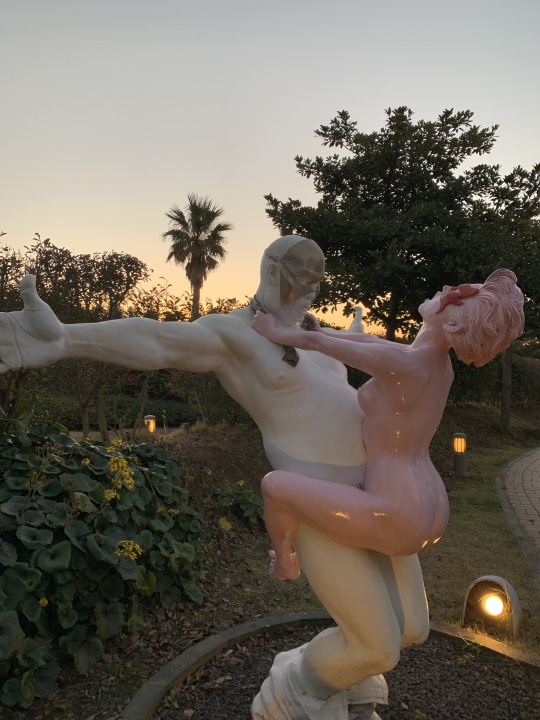
Cost: ₩12000
Opening Hours: 09:00-24:00 (last entry: 23:00)
Suggested Duration: 1.5 hours
Address: 2894-72, Cheonbaengi-ro, Jeju-si, Jeju-do 제주특별자치도 제주시 1100로 2894-72 (연동)
Note: Visitors must be 20 years of age or older
Shopping in Jeju City
We ended the night by shopping along Singwang-ro in Jeju City. In this area, you can find retail and makeup shops like Artbox, Innisfree and Nature Republic, which are perfect if you want to get a gift for the holiday season or simply buy a few packs of face masks home to add to your nightly skincare routine.
Day 4: East Coast of Jeju and Jeju City
We hired a private driver and car from KKday to take us around the East coast of Jeju Island. However, if you are traveling alone, check out this tour on Klook.
Gwangchigi Beach
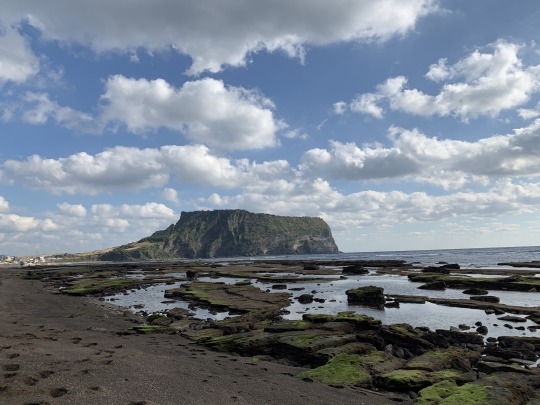
Suggested Duration: 15 minutes
Udo Island
I will share our itinerary for Udo Island in the third post of my Jeju series. Check out Udo Island’s delicacies in my Jeju Food Guide (second post of the series: click here).
Seongsan Ilchulbong Peak (Sunrise Peak, 성산일출봉)
The hike up and down will take you ~1 hour but the view from the top is worth it. This peak is not only one of Jeju’s most well-known attractions, but is also a UNESCO World Heritage site
On your way down, keep a lookout for Jeju’s Haenyeo 해녀 (female divers). You can catch the haenyeo perform at 13:30 and 15:30at the bottom of the crater. This community of women (mostly aged 60-80) gather shellfish for up to 7 hours daily, 90 days a year, to make a living. They can dive around 10m under the sea without oxygen masks. Before every dive, the Haenyeo make a prayer to the Jamsugut (goddess of the sea) to ask for safety and a good catch. The culture of Jeju Haenyeo was inscribed in 2016 on UNSECO’s Representative List of the Intangible Cultural Heritage of Humanity. For a more personal account of the stories of the Haenyeo, read https://roadsandkingdoms.com/2017/the-female-free-divers-of-jeju/.

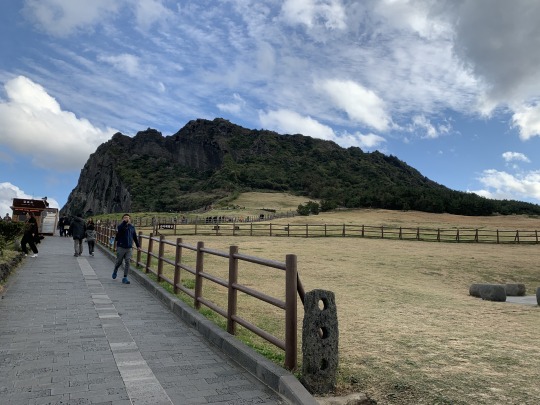
Cost: ₩2000
Notes: The trial is closed on the first Monday of each month
Day 5: Jeju City
Dongmun Traditional Market (제주동문시장,동문재래시장)
At Jeju’s oldest street market, you can explore Korean street food. We enjoyed banana mochi, live octopus and abalone! Check out my Jeju Food Guide for more details.

Opening Hours: 08:00-21:00
Suggested Duration: 1.5 hours
Address: 20 Gwandeong-ro 14(sipsa)-gil, Idoil-dong, Jeju-si, Jeju-do, South Korea
Yongduam Rock (용두암)
The Yongduam Rock looks like a Dragon Head and is a unique photo spot. The rock was created by strong winds and waves over thousands of years. Legend has it that a dragon stole jade from Hallasan and consequently, was shot down by the mountain deity. When the dragon fell, his body sank into the ocean but his head froze into rock.
Suggested Duration: 20 minutes
Address: Yongduam-gil, Jeju-si, Jeju-do 제주특별자치도 제주시 용두암길 (제주올레길17코스)
Notes: The Yongduam rock is near Jeju International Airport, so you can take a taxi directly to the airport after your visit this attraction.
0 notes
Photo
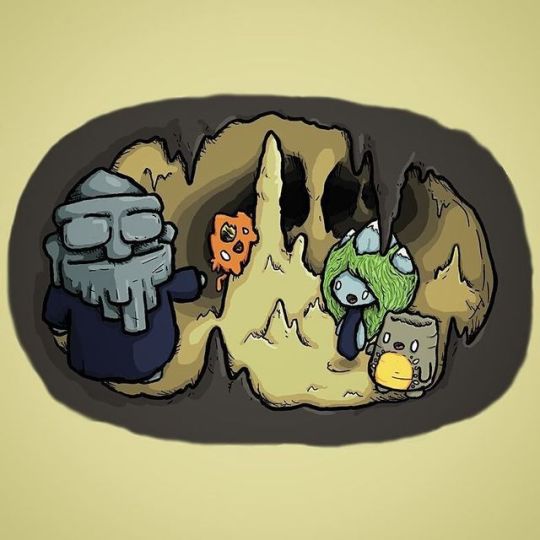
돌하르방과 함께하는 동굴 탐사. Cave trip with a dol hareubang. #jeju #jejuisland #illustration #drawing #cartoon #cave #dolhareubang #art #제주 #제주도 #동굴 #돌하르방 #일러스트 #드로잉 #그림 #만화 http://ift.tt/2hMeDqa
1 note
·
View note